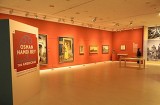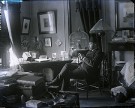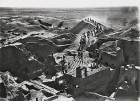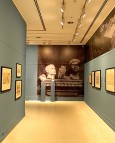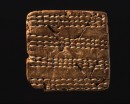The browser will either open the file, download it, or display a dialog.
Osman Hamdi Bey and the Americans: Archaeology, Diplomacy, Art
The Suna and Inan Kıraç Foundation Pera Museum, Istanbul
October 14, 2011 – January 8, 2012
Archaeologists and Travelers in Ottoman Lands
University of Pennsylvania Museum of Archaeology and Anthropology, Philadelphia
September 26, 2010 – June 26, 2011
Catalogue:
Osman Hamdi Bey and the Americans: Archaeology, Diplomacy, Art (Osman Hamdi Bey & Amerikalilar: Arkeoloji, Diplomas, Sanat)
Edited by Renata Holod and Robert Ousterhout, with essays by Renata Holod, Robert Ousterhout, Susan Heuck Allen, Bonna D. Wescoat, Richard L. Zettler, Jamie Sanecki, Heather Hughes, Emily Neumeier, and Emine Fetvaci.
Istanbul: Pera Museum Publication, 2011.
411 pp.; 96 b/w; 119 color; bibliography
90TL (Turkish Lira)
ISBN 978-975-9123-89-5
The quietly monumental exhibition, titled Osman Hamdi Bey and the Americans: Archaeology, Diplomacy, Art, was the product of a surprising collaboration between the Suna and Inan Kıraç Foundation Pera Museum in Istanbul and the University of Pennsylvania Museum of Archaeology and Anthropology in Philadelphia. The exhibition, on display in Istanbul from October 15, 2011 – January 8, 2012, was a hidden gem on the third floor of the Pera Museum (fig. 1). In three small galleries, the curators Renata Holod and Robert Ousterhout (both from the University of Pennsylvania) framed a topic refreshing for art and archaeology museums alike: the intersecting lives of three figures central to the establishment of Ottoman-American relations in the archaeological field at the end of the nineteenth century: Osman Hamdi Bey, John Henry Haynes, and Hermann Vollrath Hilprecht.
Centering on a thematic exploration of diplomacy and its impacts on art and archaeology, the exhibition was seamlessly interdisciplinary in concept and in its translation to didactic exhibition space. The creators drew from a rich variety of sources spread among the exhibition’s thematic sections: Orientalist paintings, architectural drawings, travel journals, documentary photographs, archaeological artifacts, and a variety of letters and documents demonstrating the depth of original research conducted for the project. Thematic organization surpassed the too often rigid exhibition categories that confine objects to a single facet of history. Rather than a chronological narrative, a constellation of stories of political and academic maneuvering unfolded naturally, providing a holistic picture of an era and provoking further study of the complex issues addressed.
The well-executed exhibition design gracefully negotiated the limitations of the small gallery space and the breadth of material. Concise wall texts translated into Turkish and English eased the viewer’s movement through the complex period of history. Beautiful enlargements of period photographs, such as those by the archaeologist and photographer, Henry Haynes, headed each section and provided visual cohesion to the small space (figs. 6 and 9). The innovative and aesthetically pleasing exhibition design brought to life what could be considered a dry, academically specific topic and appealed to novices and experts in the field alike.
The Pera Museum advertised two recently re-discovered paintings by Osman Hamdi Bey from the University of Pennsylvania’s Museum of Archaeology and Anthropology. At the Mosque Door (fig. 5) and The Excavation at the Temple Court in Nippur (fig. 11) have remained in the United States for the past one hundred years, and their exhibition in Istanbul is fitting given Hamdi Bey’s status as a ‘pioneering’ Turkish artist. Newly discovered photographs by John Henry Haynes, dusted off and brought out of the archives at the University of Pennsylvania, appealed to those interested in late nineteenth century documentary photography (figs. 6, 7, 8).[1]
However, the exhibition’s true success lay in its explorative nature. The concept for the exhibit originated from a graduate level curatorial seminar held in 2009, and led by professor Robert Ousterhout, chair of the Graduate Group at the University of Pennsylvania, which explored Ottoman-American relations in the late nineteenth century. The topic expanded into a symposium, titled “Recovering the Past,” held in the spring of 2010 at the University of Pennsylvania Museum of Archaeology and Anthropology; it included papers by scholars from across disciplines and institutions (some of which were later included in the catalogue published by the Pera Museum in 2011). The University of Pennsylvania Museum also featured an exhibition, Archaeologists and Travelers in Ottoman Lands, from September 26, 2010 to June 26, 2011. With a new and unique angle, the concept evolved once again into the exhibition Osman Hamdi Bey and the Americans: Archaeology, Diplomacy, Art held at the Pera Museum in Istanbul. The concision of the project’s most recent iteration at the Pera Museum demonstrates a thoroughly conceptualized topic rooted in original research and shaped by a joint collaboration between students and scholars across disciplines. The exhibition’s six thematically organized sections are: I. Three Intersecting Lives; II. The Beginnings of Ottoman Archaeology; III. Artist and Bureaucrat: Osman Hamdi Bey; IV. The Unknown Photographer: John Henry Haynes; V. The Beginnings of American Archaeology: Assos (1881–1883); and VI. Nippur: The First Great Discovery.
I. Three Intersecting Lives
In the first exhibition section, “Three Intersecting Lives,” photographs, documents and concise biographies introduced the viewer to the lives and dynamic personalities of a diplomat, scholar, and photographer: Osman Hamdi Bey, Hermann Vollrath Hilprecht, and John Henry Haynes (fig. 2). It quickly became clear that the men played several roles in their careers as their lives intersected in the archaeological context. Hamdi Bey was a diplomat, painter, archaeologist, and pioneering museologist as the director of the Imperial Museum and founder of the Istanbul Academy of Fine Arts. Hermann Vollrath Hilprecht was the first “Assyriologist” and professor of Near Eastern studies at the University of Pennsylvania. He worked between Philadelphia and Istanbul, guiding archaeological expeditions and cataloguing the excavated materials. John Henry Haynes documented the first American expeditions in the Ottoman Empire through photography. Haynes was also a leading archaeologist during the Nippur excavations led by the University of Pennsylvania. He received heavy criticism from Hilprecht for being an untrained archaeologist and employing improper methodology at the site.[2] Interpersonal dynamics are explored further in the accompanying catalogue essays.
Photographic portraits of the three figures at work, (most of which were dug out of the Archives of the University of Pennsylvania Museum of Archaeology and Anthropology), demonstrate the characters’ dual roles as each figure dons both western and Ottoman attire. Costumed flattery often accompanied diplomatic relations between east and west. For example, a carte-de-visite made during the Vienna World Exposition of 1873 depicts Hamdi Bey wearing a traditional Ottoman Empire costume, clearly to display ethnic costume to westerners rather than portray himself as integral member of the Ottoman cultural elite versed in western traditions as he does in other photographs also exhibited. Likewise, a portrait of Hilprecht in his Istanbul study sporting a fez and examining a cuneiform tablet typifies the western academic fascination, (perhaps evincing academic pompousness), with newly discovered archaeological sites in the east (fig. 3).
II. The Beginnings of Ottoman Archaeology
The next exhibition section, “The Beginnings of Ottoman Archaeology”, sets the re-development of the Ottoman State’s Regulation of Antiquities as a marker of a new era in cultural heritage policy (fig. 2, on left). Drafted by Hamdi Bey himself, the goal of the new legislation was to prevent outside parties from depleting the Ottoman Empire of its ancient treasures, which were being discovered en masse during a time of frantic archaeological exploration. Numerous photographs of the first sites organized under this policy depict Hamdi Bey on site next to ancient discoveries and situate him as a central figure in early Ottoman archaeology. Watercolors and hand-tinted photographs excerpted from Une Nécropole Royale à Sidon. Fouilles de Hamdy Bey(A Royal Necropolis in Sidon: Excavations of Hamdi Bey) depict the Alexander sarcophagus discovered during the Sidon expedition (fig. 2., vitrine on left).[3] Such findings and their documentation mark the beginning of an era in which debates over ownership of cultural heritage sought to prevent looting of sites and to bolster national identity.
While this section emphasizes a range of impressive discoveries at the sites themselves, it only hints at the relationship between Ottoman archaeology and the enforcement of national identity. Massive discoveries of the Empire’s ancient heritage undoubtedly unearthed questions concerning national and cultural identity and elicited their exploitation by authorities. Perhaps a discussion of national identity would require a larger exhibition space. However, it is an integral part of the diplomatic relations between two large world powers at the end of the nineteenth century that begs for more in-depth discussion.
In a transition to the following section, “Artist and Bureaucrat: Osman Hamdi Bey,” a computer containing digitized letters and official documents allows viewers to peruse evidence of the growing interest in archaeological sites on Ottoman lands at their leisure. In a letter dated 1893, Hilprecht introduces himself to Hamdi Bey, then director of the Imperial Museum in Constantinople. In a show of gross flattery, he begs “His Excellency” to allow him to examine the treasure trove of Babylonian antiquities at the Museum in Constantinople.[4] Soon after the date of the letter, Hilprecht inserted himself into the excavations at Nippur as the scientific director. Complaining of the inhospitable conditions, most of his direction was given from afar. Eventually, Hilprecht catalogued Mesopotamian materials at the Imperial Museum in Constantinople with the intention of acquiring a choice selection of cuneiform tablets from the Nippur site for the University of Pennsylvania, (and to claim credit for their discovery). In fact, by the end of his career, Hilprecht, Professor of Assyriology at the University of Pennsylvania, was forced to resign from his field for academic dishonesty in 1910.[5]
III. Artist and Bureaucrat: Osman Hamdi Bey
As the title of the exhibition implies, Osman Hamdi Bey was the central and best-known figure of the American-Ottoman cultural relations during the late nineteenth century, not surprising considering the exhibition’s Turkish context. While his presence is maintained throughout each part of the exhibition, the section “Artist and Bureaucrat: Osman Hamdi Bey” examines a small selection of his paintings relating to his relationship with the west (fig. 4). Born in 1842, Hamdi Bey was a cultural leader and intellectual in Constantinople at the end of the nineteenth century. The exhibit’s creators outline the complex roles as an artist, archaeologist, administrator, and diplomat that Hamdi Bey played as the Americans wrestled their way into bible-land archaeological sites on Ottoman territory. Biographical information culled from letters, paintings, photographs and political documents portray Hamdi Bey as integral to bringing progress to his country at a time when modernization, and ultimately westernization, was the goal of the Ottoman Empire. He drafted trade laws protecting the Empire’s antiquities, established the School of Fine Arts in Istanbul and administered the building of the Archaeological Museum; and the Pera Museum had ample material to paint him as a national hero. However, his life in the context of the exhibition is neither heroized nor criticized. Instead, the exhibit’s creators examine his life’s work as part of a complicated web of east-west relations part of the inevitable struggles of modernization in which, if anything, Hamdi Bey falls victim to diplomatic pretenses.
Hamdi Bey studied in Paris under Gustave Boulanger, from whom he appropriated the visual tropes of French academic orientalism epitomized by Jean-Léon Gérôme. Following in the tradition of French academic orientalists, Bey often painted from photographs. The hodgepodge of ethnographic materials and discrepancies of perspective often result in frozen narratives in Bey’s paintings, due to his collage-like use of photographs. Hamdi Bey himself, photographed in ethnographic costume, was often the sole male model for his paintings. Even though painting is not the focal point of the exhibition, this section would have benefitted from a deeper study of Hamdi Bey’s painting practice in relation to Ottoman-American relations by including more photographic studies.[6] The paintings on view demonstrate his appropriation of French academic orientalism to construct an image of the Ottoman Empire for a particular western audience.[7]
While it was not the overt goal of the exhibition’s creators, it became apparent that Hamdi Bey’s diplomatic duties often thwarted his career as a painter. The exhibit details the life of the painting At the Mosque Door (fig. 5), which was purchased by the University of Pennsylvania in an expensive act of flattery. Though he had his own agenda in depicting ethnographic elements of Ottoman culture, Bey’s management of all archaeological activity in the Ottoman Empire provided him with much praise for his paintings and an honorary doctorate from the University of Pennsylvania—all of this, of course, in exchange for Mesopotamian antiquities excavated from Ottoman archaeological sites.[8] Not even on public view at the 1893 World’s Columbian Exhibition in Chicago, At the Mosque Door disappeared into storage soon after the University of Pennsylvania received the cuneiform tablets desired from Ottoman excavations.
IV. The Unknown Photographer: John Henry Haynes
Until this exhibition, the work of archaeologist and photographer John Henry Haynes remained in relative obscurity. The section, “The Unknown Photographer”, frames Haynes as the forgotten “father of American archaeological photography.”[9] Many of his lush photographs were unpublished, misattributed, or lost. The bulk of those exhibited were found in the archives at the University Pennsylvania Museum of Archaeology and Anthropology, the result of Haynes’ involvement with the University-led excavations at Nippur. The viewer first encounters photographs taken during his travels across Asia Minor (fig. 6). A map details Hayne’s route where he took some of the earliest photographs of archaeological sites such as those at Assos and Cappadocia. Images of rock formations, mausoleums, and mosques occupy the photographs in silence. However, through the occasional figure, horse, or gun, (used for scale), Haynes contextualizes the ancient monuments in the late-nineteenth-century Ottoman Empire. Excerpts from his diaries included in the exhibit document the difficulties of travel and excavations during a time when modern technologies had yet to be introduced to the Ottoman Empire.
After viewing the selection of photographs, it becomes clear that it was not Haynes’ intention to simply document ancient sites. The people and monuments in his photographs function as compositional elements in carefully constructed images. For example, Haynes creates an optical illusion in Hittite Lions (fig. 7). A man on a horse poses next to a massive statue of a lion and echoes the monument’s pose, appearing to be the size of a toy. Nippur Temple Excavation captures the monumentality of the site in poetic reverence through dramatic light and shadow (fig. 8).[10] Artistic parallels between Hamdi Bey and Haynes were not explicitly explored in the exhibition, even though they shared interests in art and archaeology and distinctions between ‘art’ and ‘documentation’ are difficult to decipher in their work. Without such questions to guide the viewer, the austere beauty of Haynes’ photographs quietly upstage Hamdi Bey’s photo-based orientalist paintings in the exhibition.
V. The Beginnings of American Archaeology: Assos (1881-1883)
The section “The Beginnings of American Archaeology: Assos (1881–1883)” presents a case study of Assos, the earliest American-led archaeological expeditions in the Mediterranean. The exhibitors re-create the site for the viewer using photography, architectural renderings, maps, and artifacts from ancient Mesopotamia (fig. 9). The intention is to examine the development of the archaeological field in America rather than to educate viewers about the site of Assos itself. Photographs by Haynes document the process of the excavations at Assos as archaeologists and workers pose, work, and relax. Francis H. Bacon’s pen and ink renderings of the acropolis, its topography, elevations and perspective drawings of the temple of Athena demonstrate the systematic approach with which the American team explored Assos. Bacon carefully measured and reproduced the artistic details (and archaeological data) of sculptured reliefs and mosaics, as seen in the numerous architectural studies presented in the exhibition, largely from the Museum of Fine Arts, Boston.
After the founding of the Archaeological Institute of America (AIA) in 1879, Assos was chosen as its first site of excavation in which careful attention was paid to methods of documentation. Letters between Haynes and Charles Eliot Norton (the first president of the AIA) demonstrate tensions between brash American personalities and Ottoman authorities.[11] This section reveals the rise of issues of ownership or ‘rights’ to antiquity. Bacon’s drawings demonstrate a distinct change in approach to archaeological drawings since the romanticized architectural ruins drawn by artist travelers in the eighteenth and early nineteenth centuries. Such romantic sentiment exists more in the photographs of Haynes than in the drawings of Bacon, demonstrating a change in media and their use.
VI. Nippur: The First Great Discovery
In the last section of the exhibition, “Nippur: The First Great Discovery”, the viewers are finally privy to the cuneiform tablets sought after by Americans and Ottomans alike (fig. 10). The nearly 54,000 tablets found at Nippur (now in modern day Iraq) comprise a monumental find in Mesopotamian history. Diplomacy turned to drama as all parties fought over access to the site and the major discovery, as documented in letters, antiquities permits and explained in wall labels. This exhibition must be a source of pride for today’s Philadelphian scholars as the eleven-year-long expedition of Nippur was the first conducted by the University of Pennsylvania. Layers of the site contain artifacts from the sixth millennium BCE to the ninth century CE from Sumerian, Assyrian, Neo-Babylonian, and early Islamic dynasties. Alongside artifacts from these societies, the final section of the exhibition displays photographs by Haynes, correspondence, publications, and the architectural sketches of Joseph Meyer.
The entirety of the exhibition leads up to the final assessment of the Nippur excavations where the intersecting lives of Hamdi Bey, Haynes, and Hilprecht come together in Hamdi Bey’s painting The Excavation at the Temple Court in Nippur. At first thought, the painting appears oddly situated at the end of the exhibition amongst the cuneiform tablets from the Nippur (fig. 10). Commissioned by the University of Pennsylvania, the scene of workers excavating the central temple court illustrates the University’s investment and pride in the Nippur excavations. Hamdi Bey painted the scene from afar using Haynes’ photographs of the temple excavation, rather than from his experience at the site (fig. 11). Haynes was field director of the site at the time of the big discovery and Hilprecht’s attempts to claim responsibility for their discovery are discussed in this section (Hamdi Bey inserted a portrait of Hilprecht seen in the lower right). The Excavation at the Temple Court in Nippur neatly summarizes his career as a painter and diplomat. Situated amongst the Nippur clay tablets and vessels, it is itself an artifact of the complicated east-west diplomatic relations.
It was unfortunate that with so few visitors in the galleries, the exhibit did not seem particularly popular. Perhaps this is because the Pera Museum is tucked away in a hip shopping district of Istanbul, distant from popular tourist destinations that profit from the city’s complex history. However, the curators also did not venture to connect the exhibition’s historically driven material to Istanbul’s younger generation sipping lattes and shopping just a few blocks away.
Exhibition Catalogue: Osman Hamdi Bey and the Americans: Archaeology / Diplomacy / Art
At 411 pages long, the accompanying catalogue published by the Pera Museum is disproportionately large in comparison to the compact exhibition. However, the acuity and insight with which its contributors flesh out multiple facets of Ottoman-American relations in the late nineteenth century attest to the richness of the exhibition’s central theme. That the contributions by historians across fields examine only objects within the exhibition testifies to the potency of items carefully chosen for display. Entries in English and Turkish address everything from the provenance of Hamdi Bey paintings to archaeological digs at Assos and Nippur. The catalogue will be an essential reference for those interested in the development of Ottoman and American archaeology and nineteenth century cultural institutions. It far exceeds the exhibition “companions” usually published (if anything) for small-scale exhibitions.
For those who are not able to afford or find a copy of the printed catalogue, an earlier version created for the exhibition Archaeologist and Travelers in Ottoman Lands, exhibited at the University of Pennsylvania Museum Archaeology and Anthropology (Sept. 26, 2010 – June 26, 2011) is available online. The online catalogue contains many more essays than in the printed catalogue, several of which are by graduate students from the University of Pennsylvania and from contributors to the 2010 symposium “Recovering the Past.” It is valuable that such a large amount of material on a little studied topic is available to the public online, as printed versions of the articles will remain accessible to only very few. The printed catalogue does, however, retain a tighter focus on the diplomatic relations between Hilprecht, Hamdi Bey, and Haynes in particular, reflecting the slightly different outlook the project undertook when exhibited at the Pera Museum. In retrospect both the exhibition and catalogue will remain monuments to an interpretive exhibition done with care and nurtured with insight.
Annika K. Johnson
Graduate Ph.D. Student, University of Pittsburgh
AKJ22[at]Pitt.edu
[1] The Collection of the Documentation Center for the Aga Khan Program for Islamic Architecture at the Fine Arts Library of Harvard University lent several photographs by John Henry Haynes to the exhibition.
[2] Jamie Sanecki, “The Painting at the Penn Museum the Excavation of the University Museum at Nippur, Mesopotamia” in Osman Hamdi Bey and the Americans, ed. Renata Holod and Robert Ousterhout (Istanbul: Pera Museum, 2011), 96.
[3] The Institut Français d’Études Anatoliennes Collection lent a copy of Une nécropole royal à Sidon. Fouilles de Hamdy Bey (Paris, 1892) by Osman Hamdi Bey and Théodore Reinach.
[4] A full translation provided by Stephanie Hagan, Osman Hamdi Bey and the Americans, 175.
[5] Hilprecht resigned from the University of Pennsylvania in 1910 after a series of controversies. Known as “the Peters-Hilprecht controversy”, critics first challenged his widely popular book Explorations in Bible Lands during the 19th Century in which he claimed credit for the discovery of the Nippur tablets (taking credit away from John Henry Haynes and John Punnett Peters). In 1910, the University of Pennsylvania found many of the Nippur tablets deteriorating in their crates. Hilprecht was accused of negligence and fled to Germany.
[6] A photograph from the Esma Arcan Collection was included that depicts Hamdi Bey donning an Arab head-covering, though it is not clear if this photograph specifically was used for a particular painting on display.
[7] An essay by Emine Fetvaci and a joint essay by Heather Hughes and Emily Neumeier explore Hamdi Bey’s painting career in the context of the exhibition.
[8] See the catalogue entry, “The Art of Osman Hamdi Bey,” by Emine Fetvaci, which examines Hamdi Bey’s use of ethnographic material in his paintings.
[9] See Holod and Ousterhout, “Osman Hamdi Bey and the Americans” in Osman Hamdi Bey, 26.
[10] Victoria Fleck points out that Haynes’ crafted compositions were inspired by “picturesque” studies of ancient architecture popular at the time, as Haynes captures the picturesque ‘modernity’ of Assos’s antiquity. Victoria Fleck, “John Henry Haynes’s Photography at Assos” in Osman Hamdi Bey, 260.
[11] A full translation of the letter is provided in Osman Hamdi Bey, 295–98.


